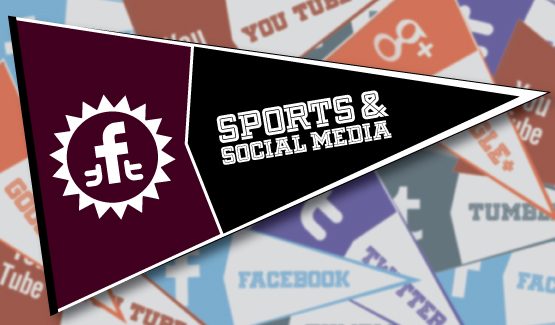
Former UCLA Softball Coach and 11 time national champion Sue Enquist discusses the growth of social media and how coaches use it to evaluate recruits. A great video to show student athletes on how important it is for them to build a positive “personal brand.”
[hr style=”1,2,3,4″ margin=”40px 0px 40px 0px”]
Social media pose risks for recruits
Adam Gorney
Recruiting Analysis
Joe Mixon‘s recruitment is getting busy. That means, in today’s world of social media, the messages on Facebook and Twitter are coming in fast and furious, too.
Most are from college coaches, friends, reporters, people he knows or has met and trusts, or people he goes to high school with at Oakley (Calif.) Freedom. It’s innocent.
But there are others. Mixon said messages come from strangers, from fans, maybe even from girls, and the 2014 four-star running back who is approaching 20 offers said it can get overwhelming. His junior year of high school isn’t over. He’s hardly on the radar.
 |
|
| Eddie Vanderdoes has slowed his activity on Twitter as signing day approaches. |
The temptation, because he’s friendly and nice, is to talk to people. Stories of late, though, especially the Manti Te’o saga, cause him to keep some distance.
“I pretty much don’t talk to everybody,” Mixon said. “I’ll favorite a tweet or retweet something, but it’s mainly people I know.
“I get a lot of messages. I look at them, but I don’t say anything or talk to everybody. It’s nothing like that.”
For Te’o, it was something like that — a story so complex and confusing that the details are still being gleaned. An online relationship turned hoax all because of Facebook. It led to an embarrassing admission by Te’o that he was fooled by a man pretending to be a woman. Dr. Phil is involved now.
And for high-profile high school football players, it’s not only the risk of having their hearts broken, their lives turned upside down by getting “catfished.”
Numerous prospects have talked about harassment on social media sites, especially Twitter, and the recruiting process becoming a hassle and a negative memory because of vicious and nasty fans. The access is unprecedented in a time when notoriety is unprecedented.
Five-star defensive tackle Eddie Vanderdoes has significantly slowed down messaging on Twitter after basically issuing a media blackout in recent weeks and deciding not to do interviews leading up to signing day. There are numerous messages from what appear to be strangers on his Twitter page.
On his recent official visit to USC, four-star linebacker Michael Hutchings tweeted a blow-by-blow account of what the recruits were doing, their schedule and what he thought about his trip. He has close to 2,500 followers.
That number is child’s play in comparison to others.
Michigan quarterback commit Shane Morris has more than 21,000 followers and has sent out north of 15,000 tweets.
 |
|
| Quarterback Shane Morris has more than 21,000 Twitter followers. |
Someone named Jason Whittington predicted on Laquon Treadwell‘s Twitter page that after his career at Ole Miss a street on campus would be named after the wide receiver. There are other messages from women telling Treadwell they love him and he’s awesome. This is all within the last 24 hours. The nation’s top-rated receiver has more than 13,000 followers and has nearly 25,000 tweets.
On Jan. 12, Tony Hooten from @aggiewebinsider wished USC commitTorrodney Prevot a happy birthday on his Twitter page and wrote: “whoTexas A&M fans hope will [be] one of the last additions to this great 2013 Aggie recruiting class! #GIGEM”
Across the country, high-profile prospects take to social media, many of them talking to strangers. There are too many examples to count. Probably most of it is innocent banter. But it could be more dangerous than these teenagers could imagine.
Ask Te’o. Or ask Michigan athletic director Dave Brandon, whose department hired two outside consulting firms to monitor the online activities of Michigan’s athletes, basically “catfishing” the school’s players in an exercise Brandon called “risk assessment.”
From a CBS Sports report citing the Toledo Blade: “One of the two consulting groups — neither of whom Brandon identified — utilized a young, attractive woman to go online and contact student-athletes.
“Did anyone take the bait? Some of them did, and they established contact online with her. The unnamed woman turned over to athletic department officials posts and comments that were made to her and the names of student-athletes. During a presentation to Michigan’s student-athletes regarding social media awareness, the athletic department introduced the woman to the student-athletes.”
Wolverines coach Brady Hoke was involved in the experiment. He and Brandon said it was to expose the players to the dangers of their communications in what Hoke called “the cyber universe.”
 |
|
| Michigan coach Brady Hoke wants players to be aware of what can happen with social media. |
But many high-profile recruits don’t enjoy the protection of aggressive athletic departments or forward-thinking coaches. They don’t have university PR machines for cover. Oftentimes, they have as much name recognition as any college football player but very little protection from scam artists on social media. Trouble can loom.
Would it be all that fanciful to believe what happened to Te’o could happen to a high school prospect? That it might be happening now? That, with the prevalence of social media, the unfettered access to these players through the computer, a plan is being hatched? That maybe some kid, somewhere, is thinking the girl he’s been talking to online isn’t a girl at all?
After the Te’o story, what seemed ridiculous and impossible only weeks ago seems plausible, even realistic.
Mixon seems to grasp the idea that there should be a line drawn, that he shouldn’t talk to every person who messages him. He’s also a 2014 prospect who hasn’t seen the full force of national exposure yet. That intoxication of celebrity hasn’t been fully realized by Mixon and other 2014 recruits.
Social media can be a great thing, reaching beyond locales to connect people. It fosters debate and discussion. It can also be a dangerous thing littered with people who have bad intentions.
“Twitter will obviously cause more harm than good for high school prospects,” Rivals.com national analyst Mike Farrell said.
“We’ve seen players lose scholarship offers and interest from schools based on their Twitter timeline, and if I’m a high school coach looking out for the best interests of my player and I see him tweet something stupid just once, I’m doing him a disservice by not making him delete his account. The question needs to be asked — what good can come from it compared to what harm can it cause?”
That question deserves serious consideration. Te’o learned a hard lesson from his adventures in social media. Will anyone else?






